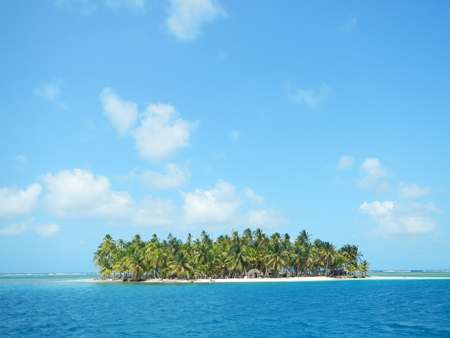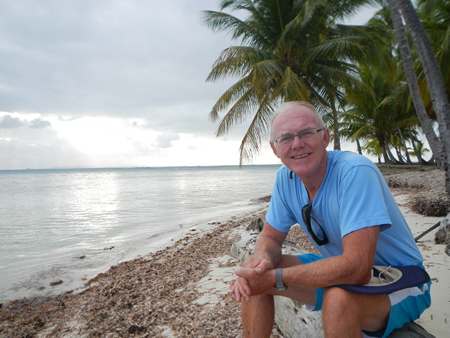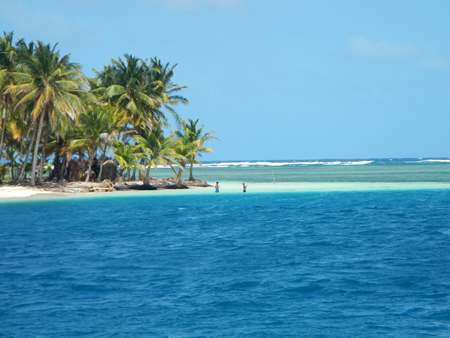San Blass

Pearl of Persia
Andrew Lock
Tue 22 Jan 2013 19:02
If a year ago anyone had told me that I would be sailing the Caribbean sea
to get to the San Blas islands I would have laughed. My sea legs and
seamanship have come a long way since we bought the boat and planned this
amazing trip. Andrew has been the best instructor I could have had.
Patient, and understanding. Cartagena was a wonderful stop, but sadly all
too short. Our guests Malcolm and Sarah Gerald had joined us in Antigua for
a couple of weeks and had a deadline to get to Panama so we left Cartagena
after only two days and set sail towards the San Blas.
To make the most of our stay in Cartegina we planned to leave at dusk, which
meant that we would have two nights and a day of sailing. There is
something a little eerie about leaving a port in the dark, as you cant see
the state of the ocean when you enter it. All is calm when you are motoring
out of the channel, but just as you get into open waters, the rolling starts
and waves hit the boat. In daylight you can adjust your balance as you
watch the waves come crashing towards the boat, but not when its dark.
Both nights were similar to our last entry. Another cycle in the washing
machine. It's amazing how exhausting it is when you have to hold on for
dear life every step you take. It's a little like being in the gym 24 hours
a day. Even when you lie down, you have to hang on, otherwise you roll off
or get thrown off the bed.
We approached the San Blas islands in the early morning light. No markers
to guide you through the shallow areas and big reefs. It's all done
visually, by having people on the deck to help the skipper wind his way
through the waters. The sun behind you and a good pair of sunglasses helps
you define the shallow from the deep.
These islands are home to the Kuna Indians who have preserved their culture
and traditions better than any other tribe in the Americas. Only one or two
of the islands have a basic land strip to allow small air craft to land.
These were built by the Americans during the second world war. Looking
around, you can appreciate that these are some of the most untouched
stretches of virgin rainforest and a cruising ground unlike any other in
its incredible beauty. The Kuna people still live a simple and basic sort
of life. The land is not divided into individual properties and fences are
absent. They have shunned any form of industrial development which is why
the landscape still looks much the same as when the Spanish first arrived
here.
At present we are anchored off a tiny island the size of a couple of
football fields. Two families live in palm huts, one each end. The women
still wear traditional dress, they still use log canoes, whole trees, felled
on the mainland, and hollowed out. From time to time, one paddles out to see
if we want to buy fish or lobster. They are non inquisitive, don't mind us
walking on the beach and smile and say 'hola' when we meet. One of the great
things about a boat is that it is possible to get to places far too remote
for the land traveller. Most islands are completely isolated with no access
at all from the outside.
Our first stop was the tiny island of Porvenir where we had to clear customs
and immigration and take our two guests off the crew list so that they could
leave. The office was a shack with nothing in it apart from a table and a
chair. The very friendly immigration officer who stamped all passports told
us that he had to charge us an extra $20 overtime as it was the weekend.
This little island has an airstrip on it, taking the full length of the
island, but there is currently a dispute between the Kuna and the official
Panamanian government, so no flights were landing or taking off. Our
friends had to make their way to the main land, by a small boat and then a 4
wheel drive along dirt trails to get them to the road and then the main
airport in Panama. (we hope they made it as we haven't heard anything from
them.)
Our plans for the next two weeks are to cruise most of these islands where
we drop anchor and enjoy the magnificent views. We spend the day attending
to any chores on the boat, then just reading, swimming, and generally doing
nothing. We are aware of your cold and frosty state back in the
UK.....however not much we can do about that.


